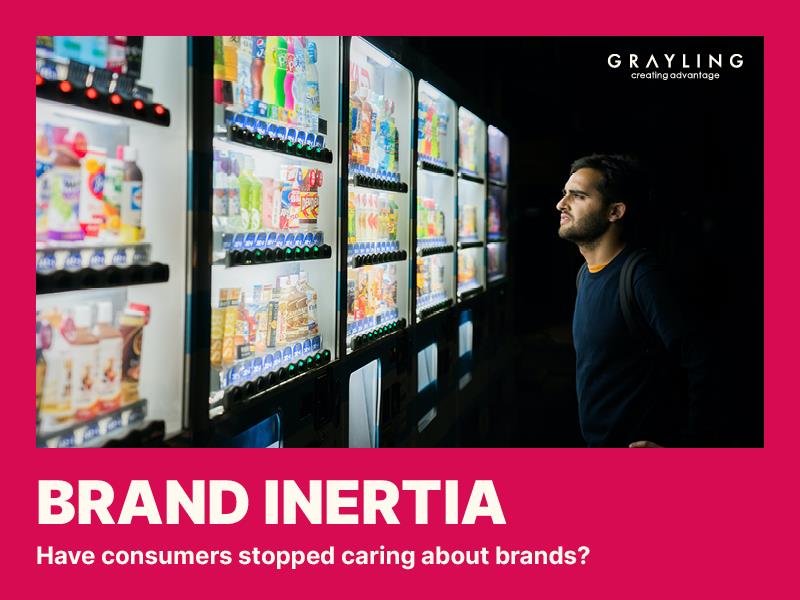(MENAFN- PRovoke)
LONDON - Nearly all consumers are showing signs of brand communications“hyper-fatigue” and disconnection from brands, according to new research from Grayling.
The report, 'brand inertia: have consumers stopped caring?' looks at the changing relationships between brands and their audiences and examines why consumers have stopped investing in brands, emotionally and financially.
Overall, 97% of consumers polled show at least one sign of inertia when it comes to the brands they choose to support. Three quarters feel that brands in the same sector are all the same and over half (56%) can't think of a single brand they feel connected with or who understands them. Convenience also remains a key consideration as 63% will reach for a go-to or familiar brand instead of researching and considering all options before purchase.
Two thirds of people with high levels of inertia (67%) say the branded content they see is usually irrelevant. As part of this trend, many forms of traditional brand communications are performing poorly as consumers literally and figuratively switch on the 'mute' button (66% are disinterested in brand advertising, 68% are not interested in brand newsletters and blogs, 52% of consumers regularly delete brand emails and texts they've signed up to without reading them).
The survey of 2,000 UK adults found that socio-economic changes over the last two years have impacted consumers' perceptions of brands, as they deal with ongoing issues such as the cost-of-living crisis, misinformation, advances in technology and purpose-washing.
Grayling head of consumer brand Estelle Boon told PRovoke Media:“For 97% of consumers to exhibit a sign of brand inertia, added to the fact 56% cannot think of a single brand they are connected to, it shows brands are in mission-critical territory. Brand inertia is a real risk and can have a negative impact on commercial growth, exposing brands to reputational risk, not to mention loss of market share. But this can be tackled. It might sound convenient for a PR agency to suggest comms as the solution, but we firmly believe that you can create advantage in an age of brand inertia.”
Boon said communicators should focus on three areas to overcome brand inertia:
- Brand identity: ensuring the brand has a clear, differentiated proposition and purpose, rooted in real-world value for the consumer.“Communication leaders need to analyse but not obsess over the competition. Identify differentiators but then adapt your messaging to reflect trends and an ever-evolving audience. This includes internal audiences that can be the biggest brand advocates when motivated.”
- Brand Elevation:“Using associations, sponsorships and experiences to connect with consumers again can have a positive commercial impact in the short-term and will continue to build long-term brand equity. Activations that elevate brands out of the quagmire and offer hope or help will produce opportunities to bond with audiences once again and nudge them out of their inertia.”
- Brand Influence:“It's more helpful right now to adopt an earned mentality, forcing ourselves to think audience-first versus channel- or message-first. By doing this, delivering brilliantly, and measuring performance live, we will start to slow down the firehose of content that is contributing so much to consumers' inertia and apathy towards brands.”
Boon said three sectors in particular were likely to feel the effects of 'brand inertia”. First, financial services and utility companies, particularly the insurance and energy sector, where there is often a brand differentiation challenge due to the nature of the product, that has been exacerbated by the stress of switching during a cost-of-living crisis.
Second, entertainment and streaming platforms that balance a fine line between being engaging content providers and contributors to consumer overload; and finally FMCG brands where there are habitual purchases, driven by promotion and convenience, requiring creative campaigns that help brands to stand out and disrupt consumer spending behaviour.
In terms of age, the research found younger people (18-24 and then 25-34) are more interested than older people in all the types of brand content (particularly that relating to charity, CSR and ESG), brand innovations, personalised content, event access and brand merchandise – more than 50% of 18–24 year olds were interested in each of these. However, younger people are also most likely to stick with products/brands because they feel overwhelmed by choice.
Boon said:“Our research reveals that young people generally convey a higher interest in branded content but experience higher inundation of that content. Older people (especially 65-year-old plus) show higher signs of brand inertia across the board - largely driven by a lack of interest and emotional connection to brands. They are far more likely to see brands as self-serving and view branded content as irrelevant to them. Unlike the younger audience, they do not favour endorsement and product diversification without clear rationale – they seek simplicity and a focus on what's core.
“These differences are interesting, but I think the real insight here is how these findings all play into the ongoing discussion about traditional demographics being dead and that brands need to focus on audience affinities when engaging the consumer. Not only is it respectful and resonant of a diverse society, but it's also a cornerstone of brand building through communications.”
The research was designed by Grayling's specialist research and data team and fielded by Yonder Data Solutions.
MENAFN18082023000219011063ID1106888052
Legal Disclaimer:
MENAFN provides the
information “as is” without warranty of any kind. We do not accept
any responsibility or liability for the accuracy, content, images,
videos, licenses, completeness, legality, or reliability of the information
contained in this article. If you have any complaints or copyright
issues related to this article, kindly contact the provider above.




















Comments
No comment